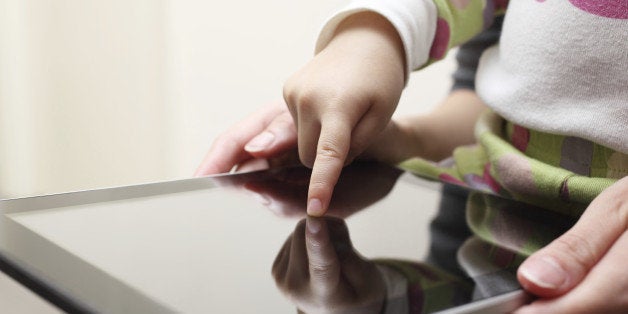
Dimitri Christakis, co-author of the American Academy of Pediatrics' (AAP) recommendations to discourage screen time for children under 2, has changed his position. He did so, despite the acknowledged lack of supporting research, based on what he frankly identifies as a "hunch" associated with development of the iPad. In an opinion piece for JAMA Pediatrics, the noted pediatrician says he now believes parents can allow up to an hour of daily "interactive" screen time for children under 2. Christakis conjectures that interactive screen time has benefits similar to playing with blocks, which is known to promote literacy.
Unfortunately for babies, his hunch has been trumpeted as news by NBC's Today.com and is morphing into a dictum for parents seeking guidance about whether and when to introduce their infants and toddlers to screens. The stories many parents will see are likely to leave out both nuance and the lack of supporting research. Already, a widely-read story on The Huffington Post reports that "babies can benefit from touch screen devices if used 30 to 60 minutes a day." A headline for another story reads "Hand over the iPad: Seattle doctor says babies should use tablets." So far, no article has included comment from the AAP or from other authors of its evidenced-based recommendations.
The JAMA Pediatrics piece, "Interactive Media Use at Younger Than the Age of 2 Years: Time to Rethink the American Academy of Pediatrics Guideline?," is confusing. The article's most succinct and visible takeaway is a misleading table comparing features of three categories of objects: "traditional toys," "touch screens," and "television." The table purports to show that touch screens have more of these positive qualities than traditional toys and television. Later, however, Christakis indicates that the table doesn't compare touch screens with traditional toys in general. Instead it seems to compare them with one unidentified toy. It's puzzling that the example Christakis gives of a "traditional toy" is a jack-in-the-box, whose sole function has always been to startle unsuspecting babies.
Christakis identifies touch screens, but not traditional toys, as "interactive," defined as able to "prompt reactions ... based on something a child does." Many traditional toys do meet that standard. A tower of blocks falls if a child builds it too high. Clay can be molded into myriad shapes. Balls roll, bounce, or veer. Even dolls and stuffed animals that neither move nor talk on their own are remarkably interactive by Christakis's definition, in that children invest them with meaning, personality, and actions that evolve over time and use.
Touch screens, but not traditional toys, are also described as "tailorable," defined as behaving differently based on the child's age and preferences, and "progressive," changing complexity as a child ages. Blocks, clay, balls, dolls, stuffed animals, and all sorts of other traditional toys meet these criteria as well. The objects themselves may not change, but they evoke evolving possibilities for use as children grow. One look at the increasing complexity in the ways an 18-month-old, a 3-year-old, and a 7-year-old play with these objects shows that they meet Christakis's criteria for tailorable and progressive.
It's troubling that many features Christakis identifies in his comparison are complex and deserve more exploration and explanation. He describes the electronic interactivity of touch screens as a potential boon for young children's learning, but ebooks that talk and make sounds at the touch of a finger have been shown to discourage the kind of adult/child conversations proven to promote literacy. There's no research on the impact of touch screens' instantaneous response on a baby's developing capacity for stamina, patience, and problem solving, but common sense suggests it should be considered.
Christakis bases his hunch on the benefits of touch screens to babies on his belief that they promote a sense of agency, or what he describes as a feeling of "I did it!" He doesn't mention that many popular apps for babies, like Play-Doh Creativity ABC's or Fisher-Price's Laugh and Learn, deprive children of agency, because their activities only allow one correct, predetermined response. In fact, a recent study shows that the "interactivity" of many bestselling apps for young children is limited to the physical acts of swiping or tapping. Most discourage the creativity, initiation, and wide range of possible responses offered by many traditional toys.
From a public-health perspective, what's most worrisome is Christakis' suggestion that as much as an hour each day of app time for under-2s is a "judicious use of interactive screen media." Since he makes no distinctions between newborns and toddlers, the article implies that it's fine for parents to start infants on tablets and smartphones from birth. It's ironic that he legitimizes daily screen use for infants at the same time that he raises concerns about the "potentially addictive" nature of touch screens.
Christakis describes the "emergence of problematic Internet use in older children and adolescents" and speculates that "we may now begin to see compulsive use of iPads among our younger children." Given the plasticity of babies' brains and the formation and reinforcement of behavior patterns by repeated experiences, why would a noted pediatrician and researcher encourage parents to begin their children's lives with an hour of daily touch-screen exposure?
The combined credibility of JAMA Pediatrics, Christakis's reputation as a researcher, and his place on the AAP Council on Media and Communication are going to make it harder than ever for parents to make informed decisions about how, when, and whether to introduce their infants to touch-screen technologies. Relevant research will be available in coming years. Given Christakis's own concern that screen time may be addictive and may replace activities proven to be beneficial, babies could be harmed if his hunch leads more parents to encourage an hour a day of touch-screen time for their youngest, most vulnerable children. Meanwhile, no baby will be harmed if parents continue to follow the AAP's current, evidenced-based recommendation and keep their infants and toddlers screen-free.
